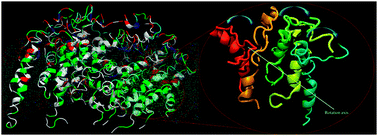The mechanisms underlying the formation of extracellular amyloid plaques on neuronal membranes, a major hallmark of Alzheimer's disease, are the subject of intense debate. Here we use multiscale simulations and analytical theory to unveil the early steps of the spontaneous self-assembly of membrane-embedded α-helical Aβ (1–40) peptides. Based on a simple analytical model describing the electrostatic repulsions among water-exposed charged residues, the presence of distorted structures called “frustrated helices” is predicted. Large scale (20 μs) Coarse Grained simulations of 36 replicas of Aβ (1–40) performed within a POPC lipid matrix confirmed the formation of supramolecular assemblies which resemble a twisted ribbon. Fully atomistic simulations have demonstrated the stability of these helical structures. Concomitant to the formation of these large assemblies, CG simulations evidenced membrane curvature and substantiate the view that these assemblies may entail mechanical stress on membrane structure. We think that these findings provide an alternative view to the traditional models that consider a conformational transition towards β-sheet rich structures as a prerequisite for triggering membrane damage and, eventually, neurotoxicity.

